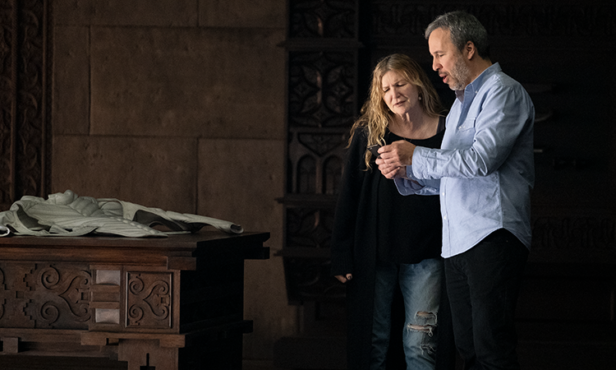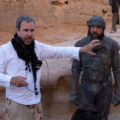Based on the novel by Frank Herbert, Dune tells the story of Paul Atreides, a brilliant and gifted young man born into a great destiny beyond his understanding, who must travel to the most dangerous planet in the universe to ensure the future of his family and his people. As malevolent forces explode into conflict over the planet’s exclusive supply of the most precious resource in existence — a commodity capable of unlocking humanity’s greatest potential— only those who can conquer their fear will survive.
There have been a few attempts to adapt Frank Herbert’s seminal sci-fi classic (including, famously, David Lynch who disowned his own Eighties version) and now’s the turn for visionary French director Denis Villeneuve (Arrival, Blade Runner: 2049.)
We find out more about the movie’s stunning costumes with costume designers, Jacqueline West ( Quills, The Revenant, Argo) pictured above with Denis Villeneuve and Robert Morgan (Batman v Superman: Dawn of Justice, X-Men: Days of Future Past, Man of Steel) who tell us what it’s like working with Denis Villeneuve and just what it takes to create costumes for whole new worlds…
How did you first get involved with Dune?
Jacqueline West: It was kind of crazy because my agent called me and told me that Denis wanted me to do this. Of course, I loved his movies, but it’s a bit out of my genre comfort zone… and I said no! Then I talked to my daughter who is a big fan of the book – a ‘Duney’ – and she said ‘you cannot say no to that!’ So I called [producer] Mary Parent who I’d worked with on The Revenant and I said ‘the definitive no, is now a definitive maybe’.
She said: ‘Great! Come to my office and meet Denis. I can guarantee you when you talk to him, you’re going to want to do this’ and she was right. I talked to him and his whole take on Dune… I knew this would be the Dune that everybody was waiting for. I could tell he had an incredible eye and was a real auteur director that I could count on. That I’d have a degree of protection.
He said: ‘The reason I want you is that you don’t do sci-fi. I don’t want this to look like a typical sci-fi film. I don’t want it to look like a video game. I love your period work that you do so much and I really want you to do this!’.
He was so compelling that I went home, I talked to my husband and he said ‘okay, I think you should do this’. He could hear the excitement in my voice. So, yes, I ended up doing it and then I brought Bob [Morgan] on because Bob has always been my supervisor on movies, but I had not had experience with specialty costumes and Bob had supervised a lot of films. It was a match made in heaven. We were just great together as a team.
Robert Morgan: Jacqueline and I have been great friends for many years. We’ve worked together many times. She contacted me and she said: ‘Would you co-design this with me?’ And I said: ‘Hmm, let me think… yes!’ I didn’t have to think hard about it. I loved the book as a kid. I love the material and Denis Villeneuve, I loved his movies, so it was really an easy yes to say. It was large in scale. We were in Los Angeles at that time and we realised that we were going to have to divide and conquer. So we worked for a while in Los Angeles, and then I took off to Budapest and started setting up our operation there.
Jacquline, how was your first foray into sci-fi with Dune?
Jacqueline West: I came kind of a virgin to the whole thing. I’d never seen Star Wars. I’d never seen the Lynch film [of Dune]. I had seen a bit of the Jodorowsky [version of Dune] so I was familiar with it and I had read the book. I’m from Berkeley, California, and I went to Berkeley and everybody in Berkeley has read Dune, trust me. Dune is the Berkeley Bible! Because it was political. It was geopolitical. It was prophetic. It was mystical.
In fact, I lived on a houseboat and the bow of my houseboat was about 30 feet from the bow of Alan Watts’ house boat, and that’s where Frank Herbert wrote Dune on the weekends! I never met Frank Herbert but a good friend of mine who’s a journalist worked with him at the Chronicle in San Francisco, told me that he wrote part of Dune on Alan Watts’ houseboat!
Robert, you’ve worked on quite a few genre projects – what was it like working on such a huge sci-fi tale as Dune?
Robert Morgan: It is such an epic tale. It is almost like four points on a compass. There are four very interrelated but distinct directions. The four houses, the Harkonnens, the Atreides, the Sardaukar and the Arrakians. Those four places were so appealing, and when you read a book like that, your mind goes to a place and designs in your head, like we all do when we read. We all see our own movie. It was such an opportunity to be asked to do a groundbreaking, epic film like this. Where even though it was made before, you’re kind of the first one out of the block again. All of it was very exciting.
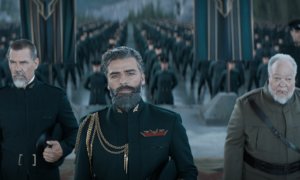
How does the role of costume designer begin?
Robert Morgan: The first thing is a meeting with the director, and a discussion and reading the script, and then a discussion about what their vision is for the film. Denis is amazing and probably one of the most collaborative people I’ve ever worked with. He’s very collaborative, we went back and forth a lot and had many discussions. He loves being involved and he would come over to the costume department and say, when we were in Budapest ‘I’m right across the lot, I’ll just come over, I want to see it, I want to see you’ he was so excited which is infectious and makes us excited!
The wonderful thing about Denis (there are many, many, many wonderful things), is that he’s one of the kindest people in the world but he gives you parameters. What it is, what it isn’t. He knew what it was and what it wasn’t. We didn’t look at it as science fiction. We looked at it as a historical tale in the future. So knowing what it is and what it isn’t, gives you a wide frame of creativity in between to explore what we felt it was.
He also amassed this group of creative people like [Production Designer] Patrice Vermette and [Hair & Makeup Designer] Donald Mowat and all these different artists. Then the cast too, which was so phenomenal…!
Jacqueline West: My first job was nailing the stillsuit. Because it was just such a seminal part of the film and so important for Denis and so perfectly described by Frank Herbert – what it did what it had to do. It was a survival suit, we’ll probably need one in Los Angeles soon [haha!] but that’s where we started. We brought on Keith Christensen, who’s a brilliant concept artist, who both Bob and I had worked with before. He started working on the stillsuit and we both sat with him and we went over all the details that are described in the book.
Then we sent maybe four or five renditions to Denis, and Denis has incredible instincts and he reacts very viscerally when he likes something. So until you get that ‘I deeply love it Jacqueline, you keep moving’, you just have to keep at it. He was my guide, so to speak. Because he had lived with it for so long, since he was 12, and had such a feeling of wanting to make it real and grounded and not so fantastical. By this time in the universe, 10,000 years from now, computers are gone and it had to be believable that it actually ran mechanically. Like it’s powered by the musculature of the body.
There were so many bodies to fit, for it to look good on from Rebecca Ferguson, I think she’s 5ft 4in. To Jason Momoa, who’s 6 ft 5in! There was a range and it had to look good on everyone. It had to also have all of the pockets and the valves and the tubing and really be believable that you could function on recycled human wastewater.
So then after we had a drawing that Denis deeply loved, we took it to Ironhead [studio], Jose Fernandez. He does a lot of the most brilliant sculptures and it was so beautiful and Denis just flipped! So then we sent that to Budapest and Bob went there. I stayed here and designed all the uniforms and the soft costumes for Jessica. Bob went ahead and hired everybody, got a factory set up to start producing the stillsuit, because that was going to have to go first to Jordan and we needed so many of them.
Then it all kind of fell into place from there. I had a level of trust from Denis by that point and I had Bob at my side making sure that everything worked and got produced. That’s how it went. So I didn’t let it overwhelm me. There were 400 specialty costumes and 2000 plus costumes in the movie and I just took it a day at a time.
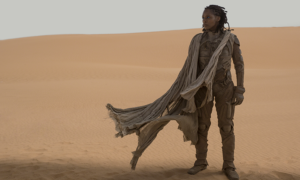
Dune is full of action and stunts – how much practicality comes into the design process of a costume?
Robert Morgan: I never work that way. My philosophy has always been that form follows function. So knowing what the costume needs to do, or what that character would need to do, or what is the environment that that army lives in? What is their station in life? What are the needs? What does a soldier need? A soldier needs protection, a soldier needs places to put things. A soldier needs camouflage. A soldier needs a lot of things. So those elements then start to help shape what that could be. Then the design follows that. Then it makes sense. You don’t see random things stuck on costumes that you wonder what that was for. That’s my approach.
I don’t think about the stunts, although later you after you’ve designed a costume, you may have to make adjustments because of the needs of the costume. Or the needs of the action or the needs of the stunt performer or visual effects – you may have to make adjustments to that.
What’s your favourite part about being a costume designer?
Jacqueline West: It’s the sittings, the initial fittings with the actors. We had such consummate great actors on this. I mean, Stellan Skarsgard… I’ve always wanted to work with him! They were wonderful, absolutely wonderful, really character-driven actors.
It’s funny, my first period film was Quills in London and when I first fit Geoffrey Rush and he got into The Marquis de Sade’s costume he became the marquis all of a sudden. His whole stature and his posture, everything changed. When you see an actor transform… I always say costumes are the bridge from the actor to the character. When you see an actor transform in front of your eyes and start moving differently and becoming the character that’s the most gratifying.
What was your most challenging aspect when working on Dune?
Jacquline West: I guess coming up with the different worlds and totally different looks for each world. The Harkonnens are obviously the goths and the dark side and that’s hard to do without being overarching. Create the dark side but still make them compelling and believable and not just baddies. I came up with this term early on for Denis – I thought to produce the future 10,000 years from now, with no computers, nothing. It’s a world starting over, that I would go to the past. So I came up with this term of ‘modieval’ and I really went to medieval times. With the exception of Duke Leto’s world on Caladan, which I based on the Romanovs. Because I thought that that was a family in decline, that everything was being taken away from. So there would be a subliminal connection with the audience. They had, I think, one of the most beautiful attires in Europe. They were simple. They weren’t baroque or flamboyant in the monarchy. It was very staid and proper and simple.
So I use the Romanovs for Caladan – the dark green, because it’s a green planet. For the Harkonnens, for Giedi Prime, I know that Jodorowsky was using [HR] Giger and I was influenced by that, but I made it much more medieval. I went to drawings of medieval monks of dark insects. So that Harkonnen helmet is like a big ant head and then I used a lot of textured motifs stamped into the leather on their armour that would reflect the world of spiders. Because when you read into Frank Herbert’s notes on Dune, Baron Harkins mother was the Black Widow.
You really have to go to Frank Herbert. There are all these onion skin layers and you peel them away and you start thinking about what his inspirations were for the Sardaukar, they’re from the planet Salusa Secundus. That stands for the SS and he even makes references to that. So they had kind of a Nazi-esque feeling. The Fremen are like the French Resistance. So they’re going to be camouflaged and practical and living behind the scenes and in the shadows. So I tried to create worlds for each of these houses.
Also colour palettes. The Arrakians are based in the Saharan desert for me so I used a lot of Tuareg references from Morocco from the Tuaregs from the salt trails of Morocco. So I approached it like that. I approached each house as a different planet, a different entity, a different feeling and a different colour palette.
Robert Morgan: You wear so many different hats [being a costume designer]. Each one of those hats is challenging and wonderful in its own way. Finding a crew, especially with the size and scope, and the talents that we needed, is a challenge. It is a busy film business and at that time, the available artisans and people that you need, get spread thinner and thinner as the business gets bigger and bigger. The more streaming services, the more content that’s being made. it thins the herd of what you’re really looking for in those people.
Luckily, I’m not a spring chicken [haha!]. I’ve worked a lot over the years and had very good relationships with many people. I’m fortunate – knock on wood – that I can call on tremendous people I’ve worked with in the past and usually if they’re not available, if I’m lucky, they’ll make themselves available. So one of the biggest challenges, I think, is staffing with the correct people.
There are all kinds of things that are challenging but I love a challenge and for this one, I guess our challenge was time and logistics. We knew we were short on time. We knew we were going to shoot in Budapest and in Jordan. But I’ve had some very wonderful mentors in my life, who have told me ‘not everything shoots the first day. So, do what’s first, first and keep an eye on the campfire in the distance and make sure if it’s getting too close to you that you figure out how to put it out’.
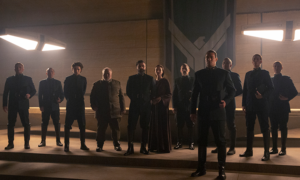
At what point does the role of costume designer finish? Are you there tweaking elements of the costume until filming finishes?
Robert Morgan: I was there until the last day of shooting and then we did some additional photography. I was there to the last day of shooting for that.
Your role as costume designer is many things. It is creating, designing, manufacturing and making sure it works. But then also, the final piece of that is to be on set when it’s established and when it’s being shot, to make sure that it is being dressed and shot in a way that you intended.
Also, to be there in case they say ‘can we take that off? Can we add something to it?’. Because things change in the moment. We have an amazing team on set, amazing costumers and craftsmen and we’re always standing by just in case things change or we need to make an adjustment. So your role is to stay there until it’s done and everyone’s happy.
Finally, we can’t leave without asking… what’s your favourite costume in Dune?
Robert Morgan: I love so many of the costumes. It’s like ‘which is your favourite child?’. You put your heart and soul into these different worlds and they are so different. The Harkonnens are so different from the Atreides, are so different from the Arrakians are so different from the Sardaukar. Like I said – four points on a compass. They’re the same compass, but each had distinct properties to them.
I love so many of the costumes – Jessica’s costumes. I love the Atreides uniforms. I love the armour for the Harkonnens, Sardaukar, The Bene Gesserit… Each one did what it needed to do in a beautiful way and I felt we achieved what we were going for.
But I did love… it was one of the very last things we did and it’s the very beginning of the film, the Herald of the Change and the Spacing Guild. It was one of the very last costumes we made. I just thought it was such a beautiful and powerful image when they came out of the ship, and were marching across to meet the Duke and Jessica. I thought that that was one of my very favourite costumes. It just had such a regal and mysterious old-world look to it. It was one of those goosebump moments when you’ve worked so hard to get it all together – it had some complexity to it with the dome and the robes – and as they came marching down it just gave me a little goosebumbs. I still get very excited when I see that on set and, when I saw it on film!
Jacqueline West: Okay, I have to say this and not just because you’re calling me from England, but I had the most incredible artistic crew and they were all from London. Almost everybody except maybe Gergely in Budapest who actually produced the Sardaukar armour in his sculpting factory. But even that was designed by Simon Brindle, a brilliant artist who stood over the torso of that costume until he was going to drive me crazy! Then all of a sudden it came all came together in one moment and everyone was thrilled. With the Sardaukars (they were based on the Templars) I had David Bethell, who is an incredible sculptor, artist, and his assistant, Ruben… everyone was from England. Helen Beasley Rachel Freire. All the people who worked in actually constructing this.
But the one thing, the one costume I have to say, is the metal veil for Lady Jessica as she gets off. Bryony Tyrrell worked on it the whole movie. It was all hand-linked, all to fit her face and the arm pieces. So brilliant. She’s a true artist. She just did the most perfectly obsessive rendition and it was all taken from medieval paintings. They actually have a picture of her doing it at Warner Brothers here in Los Angeles. She worked on it the whole movie and Bob says it’s the most expensive costume ever made haha!
Dune is available on digital download now and 4K UHD, Blu-Ray, DVD and VOD now. Read our review here.
